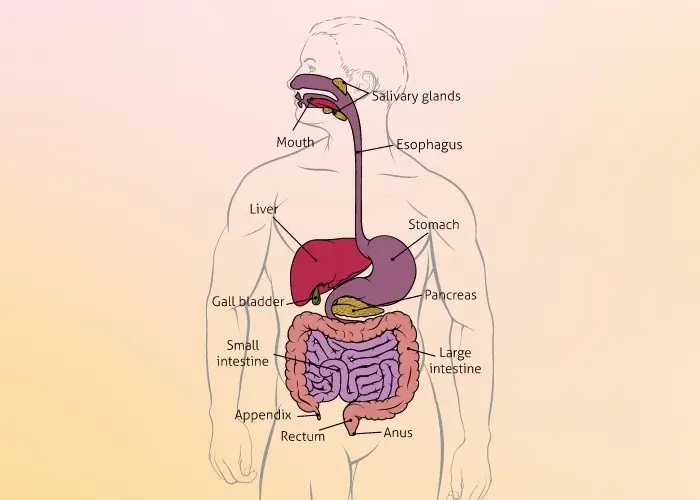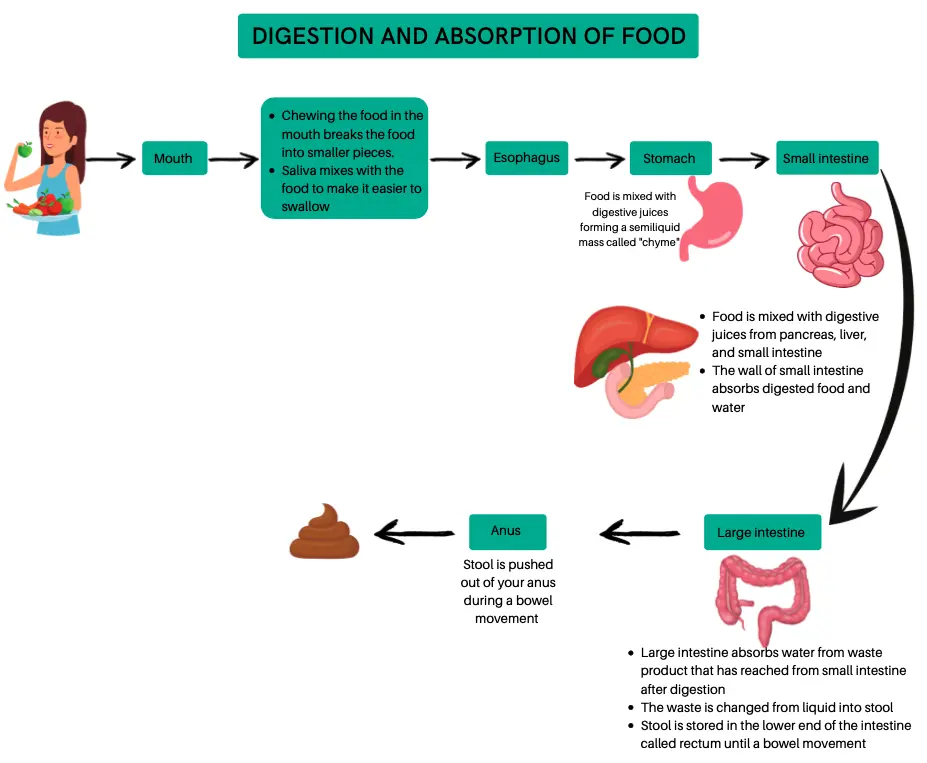The human body with various systems, including the digestive system, is intricate and complex. All the systems work synchronously to sustain the body functions. The gut-brain connection is one such example demonstrating the link between the brain and digestive system. The thought of eating or watching a cooking show showing a fresh-baked apple pie can release stomach juices. The connection goes both ways. A troubled gut can send signals to the brain. Similarly, the endocrine system (network of glands in your body) works in coordination with the digestive tract to digest and absorb food. The respiratory system, heart and circulatory system work together to purify the blood, supply oxygen to various organs, and remove carbon dioxide.

The human digestive system, which is 30 feet in length in adults, is a series of connected organs leading from the mouth to the anus. It is divided into 5 parts:
- Mouth
- Esophagus
- Stomach
- Small intestine (small bowel). The small intestine parts are Duodenum, Jejunum, and Ileum. Duodenum connects the stomach to jejunum, and ileum is the lower end of the small intestine that connects to the large intestine.
- Large intestine (large bowel) including rectum and anus
- Liver, pancreas, and gallbladder add secretions to support digestion
Mouth
Chewing the food in the mouth breaks the food into smaller pieces. Saliva mixes with the food to make it easier to swallow. Saliva contains enzymes and immunoglobulins. Immunoglobulins reduce the growth of certain bacteria hence preventing tooth decay. Enzymes break down starches and fat components in the food. As the food passes into the esophagus, a small flap of tissue called epiglottis prevents the food from passing into the windpipe by folding over the windpipe.
Esophagus
Esophagus, a tube-like structure that is about 10 inches long connects the mouth to the stomach. The food passes through the esophagus into the stomach by a process called peristalsis, wave-like movements that push the contents forward. A ring-like muscle at the end of the esophagus controls the passage of food into the stomach. It prevents the food from backing up into the esophagus.

Stomach
The stomach is a pouch-like structure located on the left side of the upper abdomen. The stomach further breaks down the food, liquifies it. Food is mixed with gastric juice. About 3 to 4 liters of gastric juice is produced per day. Gastric juice is made up of hydrochloric acid, digestive enzymes besides other substances that are important for absorbing nutrients. Hydrochloric acid makes gastric juice acidic. Acidic juice kills bacteria. The innermost layer of the stomach wall has a protective coating. Along with bicarbonate produced by glands in the stomach the protective coating ensures that the stomach wall itself is not damaged by hydrochloric acid.
Stomach is the major site for protein digestion which is mediated by digestive enzymes and hydrochloric acid. The stomach contents are mixed with the help of contractions and relaxations of the smooth muscles of the stomach. The semiliquid mass consisting of partially digested food and gastric juice is called “Chyme.” Chyme moves into the small intestine. Pyloric sphincter, a ring like structure that connects the stomach and small intestine regulates the movement of chyme from the stomach into the small intestine.
Small intestine
Small intestine is a 20 feet long tube-like organ with a highly folded surface containing finger-like projections called villi. The digestion of proteins, fats, and carbohydrates is completed here.
Small intestine is divided into three parts:
- First fixed part that is “C-shaped” is called duodenum which is separated from the stomach by pyloric sphincter.
- Jejunum is the second part that connects the duodenum to ileum
- Ileum is the third part of the small intestine which connects to the large intestine
In the duodenum, the chyme mixes with the pancreatic juice which comes from the pancreas. Pancreatic juice is rich in bicarbonate that neutralizes the acidity of the chyme. Pancreatic juice also contains enzymes that are required for digestion of proteins and carbohydrates. Digestive juices from the liver and gall bladder called “Bile” which flows into the duodenum aids in breaking down and absorption of fats.
Most carbohydrates and amino acids are absorbed in the jejunum.
Bile salts and vitamins are absorbed in the ileum. The undigested food goes from ileum into the colon or large intestine via peristaltic movements (wave-like movements that push the contents forward)
Large intestine
Large intestine is smaller in length and wider in diameter as compared to the small intestine. The colon is home to many bacteria or ‘microbiota” that aid in digestive processes.
The parts of the large intestine are:
- Cecum, the receiving pouch of waste matter that joins the ileum to the colon
- Ascending colon
- Transverse colon
- Descending colon
- Sigmoid colon
- Rectum, the lower end of the large intestine which connects to the anus through two sphincters – voluntary and involuntary which control elimination
- Anal canal and anus
The remaining liquids and electrolytes are absorbed from the undigested food in the large intestine. The waste matter is turned from liquid into a stool. The stool is stored in the rectum until a bowel movement. The stool is propelled out using wave-like movements during a bowel movement through the anus.

When the human digestive tract does not run smoothly as it is supposed to be in some people, it leads to ailments. Inflammatory bowel disease (IBD), irritable bowel syndrome (IBS), celiac disease, constipation, diarrhea, heartburn, peptic ulcer disease, gastroesophageal reflux disease (GERD) and many more ailments can be manifestations of problems in the digestive tract.
Maintaining a healthy lifestyle can keep your digestive tract healthy. Eating a balanced healthy diet, not smoking, physical activity several times a week, reducing stress, and keeping the weight in the healthy range will help in keeping this complicated machinery working smoothly.
“Life is better when sinuses are clean, when your arteries are clean, and when your digestive tract is clean”
James Altucher
“Quite literally, your gut is the epicenter of your mental and physical health. If you want better immunity, efficient digestion, improved clarity and balance, focus on rebuilding your gut health”
-Kris Carr


